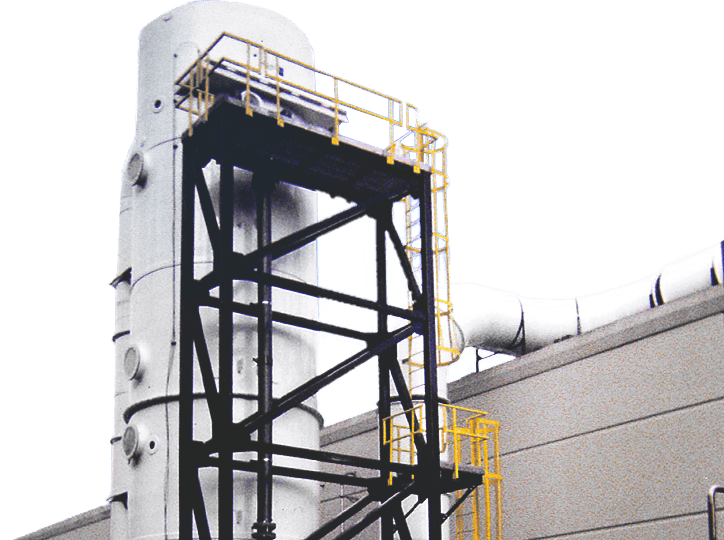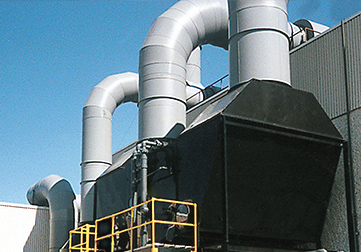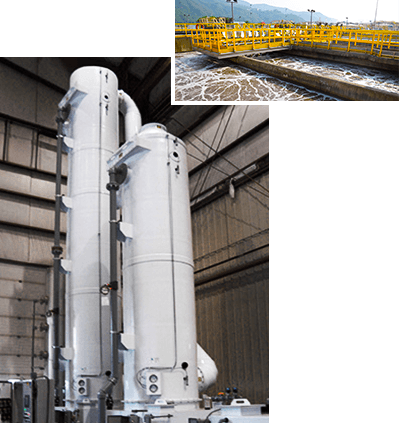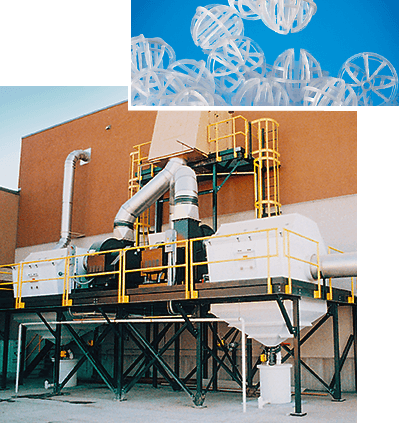Industrial Odor Control Scrubbers

Odor Control
Tri-Mer odor control scrubbers eliminate noxious and nuisance odors from a broad spectrum of industrial and municipal processes.
These industrial odor scrubbers can simultaneously handle secondary inorganic compounds, and reactive materials including acids and other gases native to industrial processes. Where particulate is involved, Tri-Mer’s Whirl / Wet dust collection technology can be incorporated.
Tri-Mer wet scrubbers for odor control are engineered to use less of the 4 resources that are typically required for the scrubbing of noxious odors: water, chemicals, media and electricity. This makes the Tri-Mer design a practical alternative with lower life cycle maintenance costs than competitive systems.

Features & Benefits
Odor control
to nondetectable level
High efficiency
Tri-Packs tower packing
Minimal
water requirements
Low
energy use
Eligible for Routine
System Performance Review
Configurations
Many Tri-Mer systems have a dual tower design; packing depth is determined by odor composition and efficiency required. The system allows optimum control of recirculation solution concentrations. Capacities range from 35 cfm to over 150,000+ cfm.
Tri-Mer systems can be readily modified to accommodate new inlet composition, throughput requirements or regulations. This is a key reason why Tri-Mer systems are among the most widely-specified in the world for control of industrial and municipal odors.


How Industrial Odor Scrubbers work
Tri-Mer odor control scrubbers have one or more independent stages. In stage 1, gas contacts an acidic scrubbing liquid to neutralize the ammonia component. H2SO4, at 10% concentration, is used down to a pH of 2. High-efficiency Tri-Packs is the standard tower packing media, with load inlet ppm determining packing depth. Scrubbing performance in all cases is guaranteed to be below detectable limits.
In stage 2, air contacts an alkali scrubbing liquid such as sodium hydroxide. Sodium hypochlorite and similar oxidizers may be added to enhance scrubber efficiency.
Sulphur and other compositions may require acid, caustic and/or oxidation stages.
Applications
Applications include food and flavors processing, breweries, pet food manufacturing, chemical and petrochemical facilities, waste treatment, asphalt manufacturing, and papermaking/ packaging. Tri-Mer systems are proven effective against industry’s most challenging odors, including:
Hydrogen sulfide: For inlet concentrations up to 4000 ppb, the concentration at the outlet or the odor control system will be less than 1 ppb. This is the lowest reported odor concentration.
Methyl mercaptan: For inlet concentrations up to 100 ppb, the concentration at the outlet for the odor control system will be less than 0.05 ppb, which is within the range of reported odor threshold concentrations.
Dimethyl sulfide: For inlet concentrations up to 1000 ppb, the concentration at the outlet for the odor control system will be less than 0.3 ppb. This is the lowest reported odor threshold concentration.
Carbon disulfide: For inlet concentrations up to 100 ppb, the concentration at the outlet for the odor control system will be less than 16 ppb, which is the lowest reported odor threshold concentration.
n-Propyl mercaptan: For inlet concentrations up to 2200 ppb, the concentration at the outlet for the odor control system will be less than 5 ppb.

Have you checked your internals lately?
Tri-Mer’s System Performance Review reports on every aspect of your air emissions system, so it always runs at peak efficiency with NO unscheduled downtime. Learn more here.
This form is the fastest way to get in touch with us.
A more detailed form, located here, will tell us what we need to generate a detailed quote.







